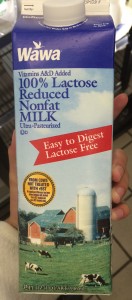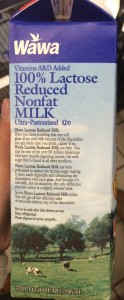The image I decided to post about was one I found on a milk carton in Wawa. In fact, it was the only milk carton that actually depicted images of cows, which I found interesting. The milk carton had an image that encompassed the entire carton – showing a blue sky, a red barn with a silo, and about five cows all spread out, grazing on green grass in the sunshine. There also was a gold stamp captioned “From Cows Not Treated With rBST” and in smaller script underneath “No significant difference has been shown between milk derived from rBST-treated and non rBST-treated cows”. 
 The cows are depicted as though they are in their most natural atmosphere, they are not anthropomorphized, but they are idealized. I find it the most interesting that the carton can display this image but not be labeled organic, humane, cruelty-free, natural…etc. Despite Foer’s explanation that these labels are “bullshit”, they still require some guidelines to be able to label themselves as such, and this milk is not following any of them. This image shows the cows as if they are on a small, family-owned farm. However, WaWa is a fairly large corporation and I doubt that five grazing cows could possibly supply the amount of milk in the time and capacity needed for such a corporation. This image depicts “happy cows” – they are free to roam the sunny atmosphere, green grass, and hospitable barn.
The cows are depicted as though they are in their most natural atmosphere, they are not anthropomorphized, but they are idealized. I find it the most interesting that the carton can display this image but not be labeled organic, humane, cruelty-free, natural…etc. Despite Foer’s explanation that these labels are “bullshit”, they still require some guidelines to be able to label themselves as such, and this milk is not following any of them. This image shows the cows as if they are on a small, family-owned farm. However, WaWa is a fairly large corporation and I doubt that five grazing cows could possibly supply the amount of milk in the time and capacity needed for such a corporation. This image depicts “happy cows” – they are free to roam the sunny atmosphere, green grass, and hospitable barn.
Jonathan Safran Foer’s definition of “organic” argues that scenes such as those pictured above are false advertising and deceptive. In his “Eating Animals“, Foer affirms that:
“For meat, milk, and eggs labeled organic, the USDA requires that animals must: (1) be raised on organic feed (that is, crops raised without most synthetic pesticides and fertilizers); (2) be traced through their life cycle (that is, leave a paper trail); (3) not be fed antibiotics or growth hormones; and (4) have “access to the outdoors.” The last criterion, sadly, has been rendered almost meaningless-in some cases “access to the outdoors” can mean nothing more than having the opportunity to look outside through a screened window.”
Taking this into consideration, what does this say about the milk that WaWa provides? If they can’t be labeled as organic, how are they treated? Certainly not like the cows on the front – who have access to the outdoors…yet apparently they do not feed them certain hormones (as stated on the carton in gold). Foer would most definitely notice the idealization of the cow’s life – this image is being used to make us feel better about our choices subconsciously and forget about the strenuous life that is the reality for many dairy cows. We forget about these animals, as Foer argues in “Hiding/Seeking”, and says that since there is no individual animal and “no singular look of joy or suffering” we are apt to forget about these animals and toss aside the thought of their suffering. This ties in very well with both John Berger and Alice Walker, both of whom argue that we’ve forgotten our connection with animals and that is why we can suppress these thoughts. Berger specifically says that animals have become “invisible” – similar to Foer saying that “we see farmed animals so rarely today, it becomes easy to forget”. We physically see the cows on this carton, but we don’t actually see the individual cow at the actual dairy farm. Therefore, we forget that this we are consuming an actual animal product, on a dairy farm that definitely does not look like this grassy pasture.
Leave a Reply